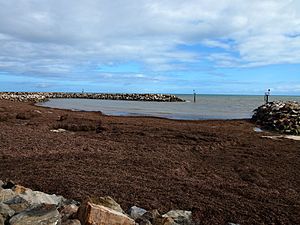Fibre-ball weed facts for kids
Quick facts for kids Fibre-ball weed |
|
|---|---|
| Conservation status | |
| Scientific classification | |
| Genus: |
Posidonia
|
| Species: |
australis
|
Posidonia australis is a special type of seagrass that grows in the ocean waters around southern Australia. People sometimes call it fibreball weed because of the round, fibrous balls it leaves on beaches. This seagrass forms huge underwater meadows, which are very important for the environment and for protecting ocean life.
Contents
What is Posidonia Australis?
P. australis is a flowering plant that grows in thick underwater fields, often in white sand or along channels. You can find it in water that is about 1 to 15 metres deep.
Under the sand, this seagrass has special stems called rhizomes and roots. These help the plant stay stable in the sand. Other parts of the rhizomes grow upwards with leaves, which helps stop mud and dirt from building up around the plant.
The leaves of P. australis look like ribbons and are about 11–20 mm wide. They are bright green but can turn brownish as they get older. The end of a leaf is usually rounded, or it might be missing if it's been damaged. The leaves grow in groups, with the older, longer leaves on the outside protecting the younger ones inside.
How Posidonia Australis Reproduces
This seagrass is a monoecious plant. This means that each plant has both male and female flowers. The flowers grow on small spikes on stems that don't have leaves. Each spike has two small leaf-like parts called bracts.
P. australis spreads its pollen through the water. This process is called hydrophily. The plant usually reproduces in two ways:
- Sexual reproduction: This involves flowers, pollen, and seeds.
- Asexual reproduction: This means the plant can make copies of itself, for example, by growing new plants from its rhizomes.
Sometimes, in very tough conditions, it can also reproduce in a special way called pseudovivipary. This is when new plantlets grow directly on the parent plant.
Scientists have recently found that P. australis is very good at soaking up carbon from the atmosphere. It can store carbon 35 times more effectively than rainforests! This makes it very important in fighting climate change.
Where Does Posidonia Australis Live?

You can find Posidonia australis in the waters along the southern coast of Australia.
In Western Australia, it grows in places like the Shark Bay area and around the islands of the Houtman Abrolhos. It also stretches south along the coast of the Swan Coastal Plain. You can find it near the Esperance Plains and the Archipelago of the Recherche on the southwest coast.
The seagrass's range continues east to coastal areas of New South Wales, South Australia, Tasmania, and Victoria. A clear sign that Posidonia seagrass is growing nearby is when you see large piles of its decomposing leaves on beaches. These often form into fibrous balls, which is why it's sometimes called "fibreball weed."
Naming Posidonia Australis
Posidonia australis belongs to a plant family called Posidoniaceae. There are eight types of this family found in Australia. The ninth type, Posidonia oceanica, lives in the Mediterranean Sea.
The name Posidonia comes from Poseidon, who was the ancient Greek god of the seas. The word australis means "southern," which refers to where this seagrass is found in the southern waters of Australia.
The species was first officially described by a scientist named Joseph Hooker. He wrote about it in his book called Flora Tasmaniae.
See also
 In Spanish: Hierba bola de fibra para niños
In Spanish: Hierba bola de fibra para niños



